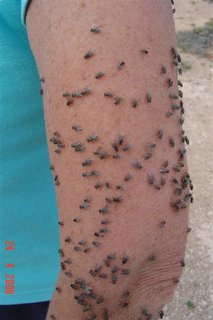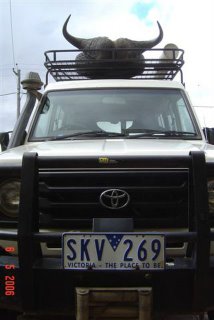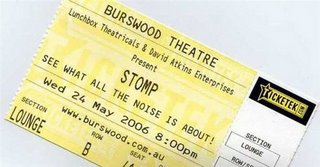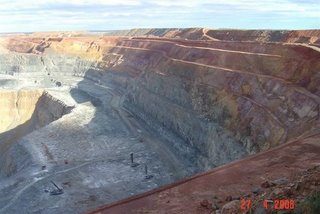Nullarbor Plain - the name implies a treeless expanse of flat, perhaps uninteresting land. It wasn’t! We discovered was that the Nullarbor does have trees. Over hundreds of years plant succession has, and presently is, changing the face of the plain. A surprising diversity of vegetation and landforms occurs.
Leaving Ceduna was through a man-made Nullarbor – a treeless landscape cleared by man for the sake of growing wheat and rearing sheep. A few pockets of mallee left as a pitiful reminder of what used to be there. The attractive eucalypt woodlands in the Yalata Indigenous Protected Area (Aboriginal land 150km from Ceduna) brought welcome relief and we kept a sharp eye out for the Dingo Fence. A pet dislike for George as he cannot understand how anyone in this day and age can justify the existence of a 2.8m high mesh fence running 6000km from South Australia to Queensland. As we entered the Nullarbor National Park we saw a dingo (a fine looking specimen) trotting across the road and wished it well.

The Bunda Cliffs, unbroken rampart along 200kms of the Bight
The Great Australian Bight actually looks as if a big bite has been taken out of the continent. Along 200km of the coast, two-toned limestone cliffs plummet 40-90m vertically into the Southern Ocean. Impatiently, we expected to find signs indicating where the best view sites were. All we could see were small tracks leading off the highway. Taking one of them we ended up on the edge of the cliff-face, looking down on swells gently rolling in, almost lapping, against the base of the cliffs below. Nothing like the fearsome action we’d seen at Coffin Bay on the Eyre Peninsula. Except for the flies and the noise of the wind sounding as if it wished to push us over the cliff … it seemed to be a fine place to spend our last night in South Australia.

Campsite above the Bunda Cliffs on the Nullarbor
The FLIES! Swarms of the bastards taking cover from the wind by clinging to our bodies and clothes, resulted in the photo below being taken in an attempt to outdo the shots of Colleen covered with bees in the Kalahari!

Flies sheltering from the wind on Lea's arm.
The flies, always at their worst in arid areas torment everyone. One has to smile at the antics of everyone doing a snake dance to rid themselves of these hitch hikers before leaping into their vehicles. Inevitably they get in with you. We’d try to beat them to death but the flies generally had the upper hand. Eventually we would drive with both doors open and blow the blighters out of the cab! How a determined young cyclist we saw pedalling across the plain coped with the flies doesn’t bear thinking! At the SA / WA border quarantine station the sight of a poodle desperately snapping away at flies in a campervan undergoing inspection, made us laugh.
Travel timing can so easily affect what we would like to see and do. The Head of the Bight, the premier whale watching spot on the coast was closed. It was too early for the whales. Access to the Eyre Bird Observatory required a phone call appointment. Our phones were out of signal range the entire Nullarbor trip. Even the Cocklebiddy caves, where the remains of Tasmanian tigers had been discovered, were closed due to heavy rains having destabilised the entrance.
On Australia’s longest straight road (146km) a convoy of mini-mokes passed us on their way … wait for it … to a “moke muster”! Approaching road trains would blow the wing mirror flat every time they thundered past us and at times the road was marked out as a landing strip for the Royal Doctor Flying Service. At one point we found two youngsters pushing their clapped out old car along a track and, after trying to start it using jump leads, landed up unhitching the caravan, leaving Lea at a truck stop and towing them back to civilisation.
We enjoyed quiet, secluded roadside camps along the way with a variety of weather – Temperature rose steadily to 37°C on one day set between mostly cold days at a low of 7°C. An approaching front brought heavy rain which caught us on a stretch of road undergoing reconstruction. Skiv and Getaway had their first good mud bath. Dead kangaroos in different stages of decomposition are generally all we see along the road. What a pleasure it was to come across live kangaroos after the rain. Only trouble being they heighten the risk of being killed by drinking from the puddles that had collected on the road’s impervious surface.

Bush camp on the Fraser's range
Nearing Norseman, a historical gold mining town at the western end of the Nullarbor, we traversed one of the most beautiful areas of all – the Dundas Nature Reserve. Said to be “the greatest untouched temperate woodland in the world” and extending over 250 000km², the sight of masses of bronze barked gimlets gleaming in the morning light; reddish-pink salmon gums and ribbon-bark gums (with their long ribbons of bark swaying in the breeze) was a sight to be seen.
And who would have believed that when pawing the ground whilst tethered to a tree, a horse first discovered gold at Norseman? It got a chunk of gold bearing quartz stuck in its hoof and went lame! A fascinating little place with accounts of prisoners being chained to logs because there was no jail and of houses being made from almost anything, including flattened bully beef tins!
 We have even had a “Rubber Tramps” sticker put on the back of “Getaway”! Lea’s chiropractor fixed her back after a grape grounded her in a Melbourne supermarket and the dentist fixed the tooth she broke on an olive pip in Hermanus. Sun worshipper George had his skin checked and cancers removed.
We have even had a “Rubber Tramps” sticker put on the back of “Getaway”! Lea’s chiropractor fixed her back after a grape grounded her in a Melbourne supermarket and the dentist fixed the tooth she broke on an olive pip in Hermanus. Sun worshipper George had his skin checked and cancers removed.






